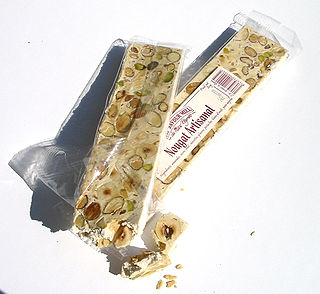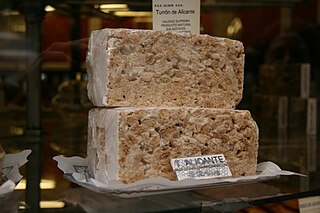
Dessert is a course that concludes a meal. The course consists of sweet foods, such as cake, biscuit, ice cream and possibly a beverage such as dessert wine and liqueur. Some cultures sweeten foods that are more commonly savory to create desserts. In some parts of the world there is no tradition of a dessert course to conclude a meal.

Confectionery is the art of making confections, or sweet foods. Confections are items that are rich in sugar and carbohydrates although exact definitions are difficult. In general, however, confections are divided into two broad and somewhat overlapping categories: bakers' confections and sugar confections.

Halva is a type of confectionery originating from Persia (Iran) and widely spread throughout the Indian Subcontinent, Middle East and South Asia. The name is used for a broad variety of recipes, generally a thick paste made from flour, butter, liquid oil, saffron, rosewater, milk, turmeric powder, and sweetened with sugar.

Pralines are confections containing nuts – usually almonds, pecans and hazelnuts – and sugar. Cream is a common third ingredient.

Nougat is a family of confections made with sugar or honey, roasted nuts, whipped egg whites, and sometimes chopped candied fruit. The consistency of nougat is chewy, and it is used in a variety of candy bars and chocolates. The word nougat comes from Occitan nogat, which means 'nutted' or 'nutty'.

Turrón, torró or torrone is a Mediterranean nougat confection, typically made of honey, sugar, and egg white, with toasted almonds or other nuts, and usually shaped either into a rectangular tablet or a round cake. Turrón is usually eaten as a dessert food around Christmas in Spain and Italy.

Marzipan is a confection consisting primarily of sugar and almond meal, sometimes augmented with almond oil or extract.

Fruitcake or fruit cake is a cake made with candied or dried fruit, nuts, and spices, and optionally soaked in spirits. In the United Kingdom, certain rich versions may be iced and decorated.

An alfajor or alajú is a traditional confection typically made of flour, honey, and nuts. It is found in Argentina, Bolivia, Paraguay, the Philippines, Southern Brazil, Southern France, Spain, Uruguay, Peru, Ecuador, Colombia, Venezuela, El Salvador and Chile. The archetypal alfajor entered Iberia during the period of al-Andalus. It is produced in the form of a small cylinder and is sold either individually or in boxes containing several pieces.
Almond bark is a chocolate-like confection made with vegetable fats instead of cocoa butter and with coloring and flavors added. It can be bought in packages, blocks, or round discs where candy and baking supplies are sold. The confection is commonly used to cover or dip fruits, caramel, oats, granola, nuts, cookies, or crackers, in place of real chocolate.

kransekage (Danish) or Kransekake (Norwegian) is a traditional Danish and Norwegian confection, often eaten on special occasions in Scandinavia. In English, the name means 'wreath cake'. In Norway it is alternatively referred to as tårnkake and often prepared for Constitution Day celebrations, Christmas, weddings, and baptisms. In Denmark it is typically eaten as part of New Year celebrations, while a variation of the cake, overflødighedshorn, is traditionally served at weddings and baptisms.

Churchkhela is a traditional Georgian candle-shaped candy.

Ma'amoul is a filled butter cookie made with semolina flour. It is popular throughout the Arab world. The filling can be made with dried fruits like figs, dates, or nuts such as pistachios or walnuts, and occasionally almonds.

Peppermint bark is a chocolate confection. Generally it consists of peppermint candy pieces, such as candy canes, in white chocolate on top of dark chocolate, but peppermint bark can refer to any chocolate with peppermint candy pieces in it.

Brabejum is a genus of a single species of large evergreen tree, Brabejum stellatifolium in the family Proteaceae, commonly called wild almond, bitter almond or ghoeboontjie. It is restricted in the wild to South Africa's Western Cape province, where it grows in thickets along the banks of streams. The plant is of botanical interest as being Africa's only member of the large grevilleoid subfamily. It is a bushy small tree with branches widely at ground level and numerous erect vigorous stems. Leaves grow up to 6 in (15 cm) long, narrow and bluntly toothed, appear at intervals along the branches, mostly in whorls of 6. In summer, the plant bears white flowers densely crowded on spikes arising from rusty buds at the leaf axils. The fruits to 2 in (5 cm) long, magenta to reddish brown, similar to an almond, appear in autumn. The nut is too bitter to eat; however, in earlier times it was boiled, roasted, and ground to make a "coffee" drink.

Sesame seed candy is a confection of sesame seeds and sugar or honey pressed into a bar or ball. It is popular from the Middle East through South Asia to East Asia. The texture may vary from chewy to crisp. It may also be called sesame (seed)candy/bar/crunch; sesame seed cake may refer to the confection or to a leavened cake or cookie incorporating sesame.















